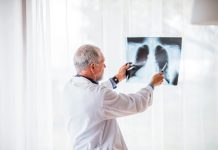
A breast cancer diagnosis can take you down a path of deeply personal choices.
If you are having a mastectomy (the removal of one or both breasts), you’ll likely have questions about the type of reconstruction to have—if you choose to have any at all.
Do you want a complex reconstruction with permanent results or a quicker one that you may need to do again later? How do you want a new breast to look and feel?
What do you want the shape of your body to be like? Might you want to skip reconstruction altogether?
It’s your body and your decision. It helps, though, to have a guide to help you figure out what’s right for you.
“Women who have a breast reduction or a breast augmentation for cosmetic reasons already know they want to change their bodies,” says Melissa Mastroianni, MD, a Yale Medicine plastic surgeon.
“But when you are diagnosed with breast cancer, it’s an unwanted choice. And you may not know what you want.”
In 2020, nearly 138,000 breast reconstructions were done in the United States among women who needed a mastectomy to either eliminate an active breast cancer or prevent it from occurring, after learning they had a genetic mutation that put them at high risk for breast cancer.
If you are one of these women, being fully informed can make the choice easier. Yale Medicine plastic surgeons answered some of the questions that can come up about breast reconstruction during or after cancer surgery.
Why is breast reconstruction an important choice for me?
How breasts look and feel may be fundamental to a woman’s body image. Much literature has been published on the psychological and social benefits of having breasts, notes plastic surgeon Haripriya Ayyala, MD.
“It is difficult to lose a part of you that helps define your femininity—you are used to a certain way that your body feels and how you look in clothing,” she says.
Studies show that women who choose to have reconstructive surgery during or right after their mastectomy often experience immediate psychological, social, emotional, and functional improvements.
That said, breast reconstruction doesn’t have to be performed right away.
Will insurance cover my breast reconstruction?
Your surgery will likely be covered by most health insurance plans, whether it’s done immediately or years later, thanks to the Women’s Health and Cancer Rights Act of 1998, which requires most insurance plans that already pay for mastectomies also to cover breast reconstruction.
If necessary, this includes surgery on the other breast to make it symmetrical with the reconstructed one.
The Affordable Care Act provides additional protections, and Medicare covers reconstruction, although Medicaid coverage varies by state.
What are my breast reconstruction choices?
Most types of breast reconstruction have improved dramatically in recent years—both in terms of how the procedures are done and their results.
“Any choice is acceptable as long as it’s a shared decision between the physician and the patient,” says plastic surgeon Paris Butler, MD, MPH.
“We are not here to persuade you to have breast reconstruction or choose one technique over another.”
Below are approaches for those who have had a mastectomy:
DIEP flap and other surgeries that use a patient’s own tissue
A microsurgery technique known as “DIEP flap” takes a flap of tissue—with blood vessels, skin, and fat—from the area of the deep inferior epigastric perforator (DIEP) artery, which is located in the belly under the navel, and reattaches it to the area where the breast was removed.
For a DIEP flap operation, the surgeon makes a hip-to-hip incision in the lower abdomen and then slowly peels the skin and fat off the belly to locate the blood vessels.
“We’re harvesting the tissue and blood vessels, and we move those up to the chest, where, using a microscope, we make connections again,” says Dr. Mastroianni.
The DIEP flap operation lasts six hours, more or less, and often is done at the same time as the mastectomy.
It requires three to four days of recovery in the hospital, followed by six weeks at home. But the new breast lasts a lifetime.
“A lot of women like that the DIEP flap uses their own tissue and that their breast will feel natural,” says Dr. Mastroianni.
As we are removing tissue from another part of the body to create breast mounds, there are also potential complication risks at the donor site, which is usually the abdomen, adds Dr. Butler.
“Those complications can be wound dehiscence [when the wound reopens], hernia, or abdominal wall weakness,” says Dr. Butler.
Implant-based breast reconstruction
Breast implants, which are also used for cosmetic surgery, come in different sizes. They can be round or teardrop-shaped and are filled with silicone gel or saline (a saltwater solution) encased in a silicone shell.
Once the diseased breast tissue is removed by mastectomy, an implant can be positioned under the remaining breast skin, where it is expected to remain for 10 to 20 years before needing to be replaced.
Implant surgery takes about an hour and a half, although it is frequently done in two steps—while some women are candidates for an immediate implant, others receive a tissue expander that slowly expands over time until the implant can be inserted at a later time during an outpatient procedure.
Many women do well with implants, but some have experienced issues and complications.
In September 2022, the FDA issued a safety communication to inform the public about rare, but important, reports of cancers, including squamous cell carcinoma and various lymphomas, that can arise in the scar tissue that forms around both saline and silicone breast implants.
Scientists previously linked a rare cancer called anaplastic large cell lymphoma primarily to implants with textured exteriors, and those implants were removed from the market in 2019.
Then, last year, the FDA added “black-box” warnings to all breast implants, citing associations with a host of chronic medical conditions, and stressed the importance of informing patients who choose implants of the risks.
In addition, “If the tissue expander or the implant gets infected, it has to come out, and you have to let the body rest for about three to six months,” says Dr. Butler. “But you can try it again.”
Aesthetic flat closure
About 35% of women who have mastectomies choose not to have breast reconstruction.
Some say that’s the choice they are most comfortable with, while others may have other medical challenges that make it too risky to undergo a reconstructive procedure.
The traditional mastectomy leaves a scar that is perpendicular to the chest wall, and breast reconstruction surgeons do their best to minimize its appearance.
“To avoid having a scar visible in a low-cut blouse, we design the flat closure so that it mimics the inframammary fold [at the lower boundary of the breast] in a crescent moon orientation,” says Dr. Butler.
“Then, if a patient chooses to get fitted for a prosthesis, it will fit nicely.” These external breast prostheses can be inserted into clothing or attached to the chest with special glue.
As it is part of the mastectomy surgery, it adds no time to the recovery process.
While many women are happy with the results, some may not truly know how they feel about their flat closure until it is done, Dr. Ayyala says.
“There are women who had a flat closure 10 or 20 years ago who were not offered the choice to have breast reconstruction.
A lot of them are coming back and asking, “What options do I have now to have breasts again?'” She tells them they can come back at any time to discuss reconstruction options.
Will I still have sensation in the reconstructed breast?
Many women are deeply disappointed by the loss of sensation after breast surgery, which can be unpredictable.
It can be influenced, in part, by whether or not a patient had a nipple-sparing mastectomy that leaves the skin, nipple, and areola intact, explains Dr. Ayyala.
“Sensation will always be altered,” she says. “But you may have increased sensation in your native nipple compared to a reconstructed one.”
Current research is looking at how to connect a nerve graft, which will reproduce sensation, Dr. Mastroianni says.
“The problem is that nerves regrow only about a millimeter each day, so it will take a long time. Plus, you need to have the ideal anatomy to be able to preserve the nerves that innervate the nipple.”
In the meantime, a reconstruction that makes the breast look and otherwise feel like it did originally can be of help psychologically, says Dr. Ayyala. “Women can have that sense of wholeness again.”
Is there anyone who can’t have reconstructive surgery?
Some women may not be healthy enough to have breast reconstruction surgery, and smokers face a higher risk of complications with DIEP flap surgeries.
“Nicotine causes blood vessels to constrict, so the vessels are smaller and can spasm, leading to flap loss,” says Dr. Mastroianni. Smoking is also known to dramatically slow wound healing.
Other women aren’t candidates for DIEP flap because of scarring from previous surgeries in the belly area, but they aren’t automatically excluded, says Dr. Mastroianni.
“CT scan imaging can help us make sure there are still good blood vessels. But if a woman has had a prior tummy tuck procedure, she can’t have the DIEP flap surgery because the area I would use to reconstruct the breast has been taken.”
Talk to your surgeon—and look at pictures, too
Every question is important, and Dr. Butler encourages patients to raise all of their questions with a plastic surgeon.
It’s also a good idea to ask a supportive partner, family member, or friend to attend the appointment with you.
It’s easy for a patient to become overwhelmed by the experience and miss key information, and another person can help, he says.
It’s also important to take time to envision what you want to look like after the reconstruction. “You have to look at pictures,” Dr. Butler says.
“Before-and-after photos of breast reconstructions, using a variety of approaches, are invaluable.”
Written by Kathy Katella.
If you care about cancer, please read studies that low-fat diet could help improve survival in breast cancer, and what you need to know cancer and booster shot.
For more information about cancer, please see recent studies about new way to increase the longevity of cancer survivors, and results showing Vitamin D deficiency linked to higher risk of breast cancer.



